|
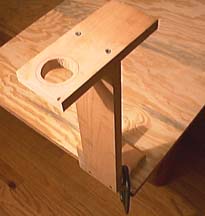 |
There are a few
pieces of minor tooling that enhance the process of making thermalite, but
they are very simple to make. First, a pedestal to hold the batter cup is
nice because it frees up the hand that normally would have to hold it.
This one can be clamped to the edge of a work bench so that the batter cup
is held out over the floor. It is made of pieces of 1 x 4, one of which
has a round hole in it for the cup. |
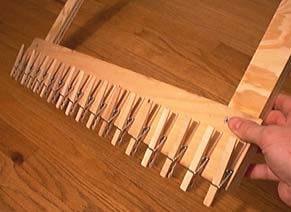 |
Here, I have made
a drying rack by using hot glue to fasten 18 clothes pins to another piece
of 1 x 4. This is hung from the ceiling of my shop so that fairly long
lengths of fuse may be suspended from it if desired. |
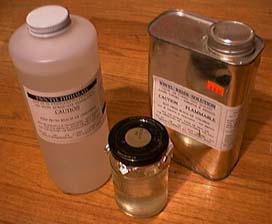 |
A binder for the
fuse composition is made by mixing the following: (parts by weight)
- vinyl resin................................. 47 parts
- nitrocellulose lacquer(10%)....... 25 parts
- dibutyl phthalate(plasticizer)..... 10 parts
- acetone.................................... 18 parts
The
vinyl resin and plasticizer are available from Firefox. Thirteen bucks
will buy enough of both to make more fuse than most people will use in a
lifetime. You can mix up a lot of the binder at once and store it in a jar
for whenever it's needed. |
 |
Now the dry
composition is prepared. This is where a good deal of caution and proper
handling becomes imperative. The list of chemical ingredients is:
- potassium perchlorate................. 37 parts
- potassium chlorate...................... 30 parts
- charcoal, air float........................ 10 parts
- magnesium, 200-325 mesh........ 15 parts
- red iron oxide, ferric..................... 5 parts
- aluminum, -325 mesh, flake.......... 3 parts
- sodium bicarbonate(additional)..... 1 part
The magnesium
should have been treated with potassium dichromate or coated with linseed
oil prior to using it in this composition. This will make it less likely
to react with any water present in the acetone. Another alternative is to
use molecular sieves to dry your acetone. The potassium perchlorate,
potassium chlorate and iron oxide are screened together first. Make sure a
screen which has never been used with sulfur is chosen for the screening.
In a separate mixing cup, the remainder of the dry ingredients are weighed
and stirred together. Finally, the two compounds are mixed together using
a gentle method called the diaper method, shown in this picture. The two
piles are placed on a large piece of paper, such as newspaper, and mixed
by picking up alternating corners to gently roll the powders over each
other until thoroughly mixed. |
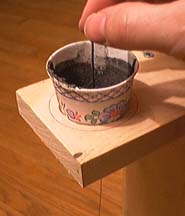 |
Prior to mixing
the binder with the dry powder, the core wires should be prepared. For a
typical batch, I cut 18 lengths of 26 gauge copper wire to a length of 19
inches. The wire is then "roughed" by pulling it through my pinched
fingertips which are holding a piece of folded sandpaper. This gives the
wire surface enough texture to allow the batter to stick to it. Now, 25
grams of dry mix and 17 grams of binder are placed in a 5 ounce paper cup
and stirred to make a batter about as thick a pancake batter. The cup is
placed in the "batter pedestal" and a small hole is poked in the bottom.
The batter should be thick enough that none will drip out of this hole.
This "first dip" is accomplished by pushing the wire up through the hole
until about an inch of it protrudes from the top surface of the batter. A
tissue is used to clean the batter from the top 1/2 inch of the wire. Then
the wire is grabbed from the top and slowly pulled the remainder of the
way through the batter. After the first dip, the batter diameter will be
quite small at about 1/16 of an inch. The wire is then clipped into the
drying rack and the procedure is repeated for the remainder of the wires.
They will be ready for the second dip in a few hours. |
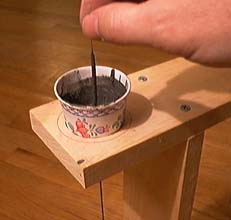 |
The second dip is
identical to the first, except that the hole in the batter cup may need to
be widened slightly to allow the thickened first dip wires to go through.
The batter can be slightly thicker for the second dip so that the coating
will be thicker also. Pulling speed will also affect the finished
thickness somewhat. Very slow pull speed allows some of the batter to
drain off, yielding a thinner coating. Both of these factors can be varied
to adjust the final diameter between the range of 1/8 inch to 3/16 inches.
It may be necessary to add a few drops of acetone and stir the batter
occasionally because this solvent evaporates so quickly. Again, the dipped
wires are clipped to the drying rack until they are completely dry. This
will take about 6 to 8 hours. |
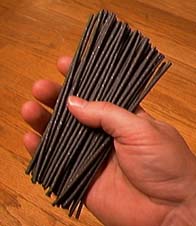 |
When completely
dry, I cut the finished igniter cord into 6 inch lengths so they can be
easily stored. The finished product is firm, but flexible. It is very
durable because the composition will not flake off easily when the cord is
bent. This stuff is quite water proof and burns with a pleasing and loud
hiss. I have found a plethora of uses for this marvelous improvisation for
thermalite. Among them are:
- It can be used as a substitute for visco in most cases, although the
slower speed variety is better for this purpose. At 3 cents a foot for
materials cost, it's less expensive, too.
- It is a very good replacement for black match when used for
cross-matching.
- I use a small length of it in the nozzle of fountains when I want to
ignite many at once with sticky match. The same concept is used to
ignite girandola drivers and most other forms of black powder rockets.
- Whenever I use sticky match to replace quick match for mine and
shell leaders, I put a piece of the thermalite at the end of the match
to assure ignition of the lift powder.
- I haven't tried this yet, but I think there is a good possibility
that short lengths of this cord could be used to make go-getter inserts
in a shell. A few wraps of masking tape with a little bit of one end
left exposed, would create very energetic little rockets. Even unwrapped
lengths will fly all over when lit if they are not attached to
something.
|
| I'll close this project
page with a few comments about the Firefox booklet. If you are seriously
contemplating this project, I highly recommend that you purchase the
booklet. It contains two different dry formulations and two binder
solutions. It will tell you how to make this thermalite equivalent in a
variety of ways to achieve a wide range of burning speeds. I have not
included all this information in my project description because Firefox
deserves to benefit from their development efforts and publication of this
material. |
|







